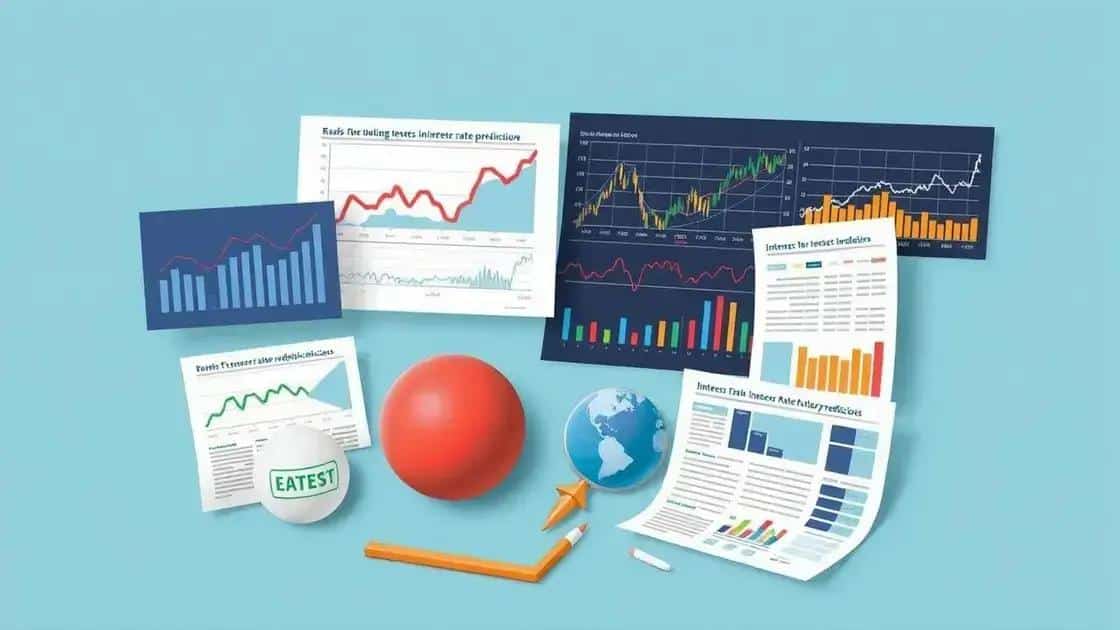Interest rate predictions and their impact on finances

Anúncios
Interest rate predictions are influenced by economic indicators, central bank decisions, and market trends, affecting both borrowing costs and savings returns, making it essential to stay informed for better financial decision-making.
When it comes to finance, interest rate predictions play a crucial role in shaping our decisions. Have you ever wondered how shifts in rates can impact your loans or investments? In this article, we’ll dive into the factors that influence these predictions and what they mean for your finances.
Anúncios
Understanding interest rates and their trends
Understanding interest rates is essential for making informed financial decisions. Interest rates determine how much you pay on loans and how much you earn on savings. With that in mind, it’s crucial to grasp the trends that affect these rates.
What Are Interest Rates?
Interest rates represent the cost of borrowing money. When you take out a loan, the lender charges you an interest rate, which is a percentage of the amount borrowed. The rate you receive may depend on various factors, including your credit history and the overall economic environment.
Anúncios
Factors Influencing Interest Rate Trends
Several key factors influence interest rates:
- Inflation: If inflation rises, interest rates often follow. Lenders want to maintain their profit margins.
- Central Bank Policies: The decisions made by central banks, like the Federal Reserve, play a significant role in setting interest rates.
- Economic Growth: As the economy grows, demand for credit may increase, leading to higher rates.
- Market Sentiment: How investors feel about future economic conditions can impact interest rates significantly.
The cyclical nature of these factors means that interest rates can fluctuate widely over time. Observing these changes can help you anticipate future trends. A strong grasp of these elements enables you to make better decisions regarding loans, savings, and investments.
As you consider your financial future, remember that understanding interest rate trends can give you a competitive edge. Using this knowledge effectively can lead to smarter financial choices that ultimately save you money over time.
Factors influencing interest rate predictions

The factors influencing interest rate predictions are essential to understand for anyone looking to navigate financial markets wisely. These factors vary from economic indicators to global events that affect supply and demand. Knowing these elements can help you anticipate shifts in interest rates.
Key Economic Indicators
Economic indicators serve as vital signs of the market’s health. Important indicators include:
- GDP Growth: A rising gross domestic product often signals a growing economy, which can lead to higher interest rates.
- Unemployment Rates: Lower unemployment typically boosts consumer spending, increasing demand for loans and possibly raising rates.
- Consumer Confidence: When consumers feel optimistic, they are more likely to borrow and spend, influencing interest rates.
These indicators interact dynamically, creating a complex landscape for predictions. Changes in any of these metrics can have a swift impact on interest rate forecasts.
Central Bank Influence
Central banks play a crucial role in interest rate predictions. Their policies directly influence how much it costs to borrow money. For example, when a central bank raises interest rates, they often aim to control inflation. Conversely, lowering rates can stimulate economic growth.
Additionally, announcements and meetings from central banks can lead to immediate fluctuations in the interest rate environment. Observers pay close attention to central bank guidance, as it provides clues on future rate actions.
Finally, global events can also affect interest rates. Situations like political instability, trade conflicts, or natural disasters may create uncertainty in financial markets, prompting changes in interest rate predictions. Keeping an eye on both local and international developments can enhance your understanding and forecasting of interest rates.
How interest rate changes affect loans and savings
Understanding how interest rate changes affect loans and savings is crucial for making informed financial decisions. When interest rates rise or fall, they can have significant impacts on how much you pay or earn.
Impact on Loans
When interest rates increase, the cost of borrowing money also goes up. This means that:
- Higher Monthly Payments: Borrowers will face larger monthly payments on fixed-rate loans.
- Increased Overall Costs: The total amount paid over the life of a loan becomes higher.
- Fewer New Loans: Higher rates may discourage people from taking out new loans, affecting consumer spending.
On the other hand, when rates decrease, borrowing becomes cheaper. This can lead to an increase in loans taken, as individuals and businesses seize the opportunity to finance their goals more affordably.
Savings Accounts and Interest Earnings
The relationship between interest rates and savings can also be significant. When interest rates rise, savings accounts typically offer higher yields. This includes:
- Better Returns: Higher rates mean that your money in savings can earn more in interest.
- Increased Savings Activity: Attractive interest rates may lead more people to deposit money into savings accounts.
- Impact on Investments: Higher rates can influence where individuals choose to invest their money.
Conversely, when interest rates drop, returns on savings decrease. This situation can lead to less incentive for saving, encouraging people to spend instead.
Overall, the dynamic between interest rates, loans, and savings is crucial to understand. Keeping an eye on these fluctuations can help in making better financial plans and strategies.
Tips for navigating financial decisions during rate fluctuations

During periods of fluctuating interest rates, making smart financial decisions can seem overwhelming. Knowing how to navigate these changes is vital to protecting your financial health. Below are some practical tips to consider when interest rates shift.
Stay Informed
Understanding the current economic climate can help you make better decisions. Keep updated on:
- Central Bank Announcements: These can signal future interest rate changes.
- Economic Indicators: Monitor reports on inflation, unemployment, and GDP.
- Market Trends: Watch how these trends impact borrowing costs and savings rates.
Staying informed allows you to react promptly and make informed choices.
Assess Your Current Financial Situation
Review your financial standing regularly. Consider your:
- Debts: High-interest debt can become more costly if rates rise.
- Savings: Higher rates might provide better returns on your savings.
- Income Sources: Ensure your income can handle potential changes in interest payments.
Knowing your financial landscape can guide you toward the best actions.
When faced with rising interest rates, consider locking in a fixed-rate loan if you plan to borrow. This strategy can help you avoid higher costs in the future. For savings, shop around for accounts offering the best interest rates to maximize your earnings.
Finally, remember to think long-term. Don’t rush into decisions based on short-term fluctuations. Consider how your choices will affect your finances over time. A well-thought-out approach can make all the difference in navigating through periods of rate changes.
FAQ – Frequently Asked Questions about Interest Rate Predictions and Financial Decisions
What factors influence interest rate predictions?
Interest rate predictions are influenced by economic indicators, central bank policies, inflation rates, and market sentiment.
How do interest rate changes affect my loans?
When interest rates rise, the cost of borrowing increases, leading to higher monthly payments and total loan costs.
What should I consider when saving during fluctuating rates?
Keep an eye on interest rates for savings accounts and consider switching to accounts that offer better returns during high-rate periods.
How can I make informed financial decisions during rate fluctuations?
Stay informed about economic trends, assess your financial situation regularly, and consider long-term implications of your decisions.





